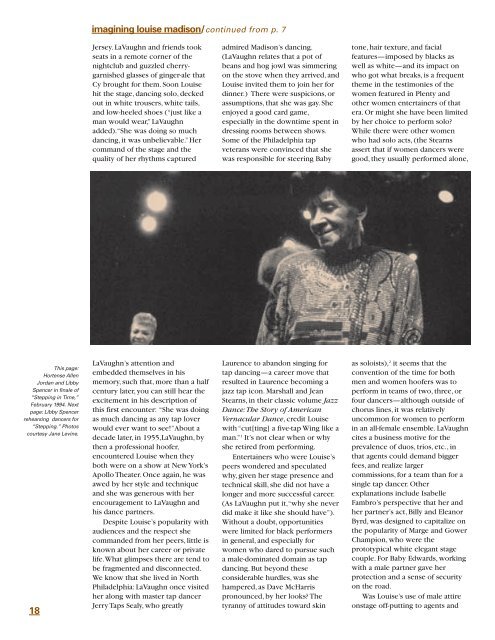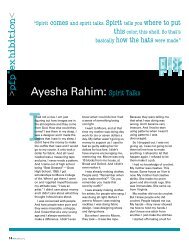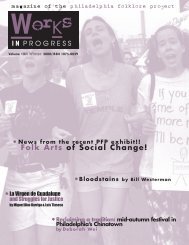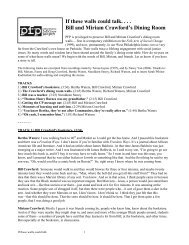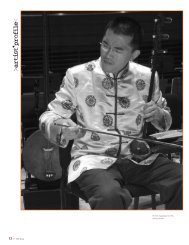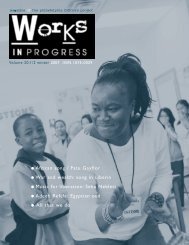View PDF - Philadelphia Folklore Project
View PDF - Philadelphia Folklore Project
View PDF - Philadelphia Folklore Project
- No tags were found...
You also want an ePaper? Increase the reach of your titles
YUMPU automatically turns print PDFs into web optimized ePapers that Google loves.
imagining louise madison/continued from p. 7Jersey. LaVaughn and friends tookseats in a remote corner of thenightclub and guzzled cherrygarnishedglasses of ginger-ale thatCy brought for them. Soon Louisehit the stage, dancing solo, deckedout in white trousers, white tails,and low-heeled shoes (“just like aman would wear,” LaVaughnadded).“She was doing so muchdancing, it was unbelievable.”Hercommand of the stage and thequality of her rhythms capturedadmired Madison’s dancing.(LaVaughn relates that a pot ofbeans and hog jowl was simmeringon the stove when they arrived, andLouise invited them to join her fordinner.) There were suspicions, orassumptions, that she was gay. Sheenjoyed a good card game,especially in the downtime spent indressing rooms between shows.Some of the <strong>Philadelphia</strong> tapveterans were convinced that shewas responsible for steering Babytone, hair texture, and facialfeatures—imposed by blacks aswell as white—and its impact onwho got what breaks, is a frequenttheme in the testimonies of thewomen featured in Plenty andother women entertainers of thatera. Or might she have been limitedby her choice to perform solo?While there were other womenwho had solo acts, (the Stearnsassert that if women dancers weregood, they usually performed alone,This page:Hortense AllenJordan and LibbySpencer in finale of“Stepping in Time,”February 1994. Nextpage: Libby Spencerrehearsing dancers for“Stepping.” Photoscourtesy Jane Levine.18LaVaughn’s attention andembedded themselves in hismemory, such that, more than a halfcentury later, you can still hear theexcitement in his description ofthis first encounter: “She was doingas much dancing as any tap loverwould ever want to see!”About adecade later, in 1955,LaVaughn, bythen a professional hoofer,encountered Louise when theyboth were on a show at New York’sApollo Theater. Once again, he wasawed by her style and techniqueand she was generous with herencouragement to LaVaughn andhis dance partners.Despite Louise’s popularity withaudiences and the respect shecommanded from her peers, little isknown about her career or privatelife.What glimpses there are tend tobe fragmented and disconnected.We know that she lived in North<strong>Philadelphia</strong>: LaVaughn once visitedher along with master tap dancerJerry Taps Sealy, who greatlyLaurence to abandon singing fortap dancing—a career move thatresulted in Laurence becoming ajazz tap icon. Marshall and JeanStearns, in their classic volume JazzDance:The Story of AmericanVernacular Dance,credit Louisewith “cut[ting] a five-tap Wing like aman.” 1 It’s not clear when or whyshe retired from performing.Entertainers who were Louise’speers wondered and speculatedwhy, given her stage presence andtechnical skill, she did not have alonger and more successful career.(As LaVaughn put it,“why she neverdid make it like she should have”).Without a doubt, opportunitieswere limited for black performersin general, and especially forwomen who dared to pursue sucha male-dominated domain as tapdancing. But beyond theseconsiderable hurdles, was shehampered, as Dave McHarrispronounced, by her looks? Thetyranny of attitudes toward skinas soloists), 2 it seems that theconvention of the time for bothmen and women hoofers was toperform in teams of two, three, orfour dancers—although outside ofchorus lines, it was relativelyuncommon for women to performin an all-female ensemble. LaVaughncites a business motive for theprevalence of duos, trios, etc., inthat agents could demand biggerfees, and realize largercommissions, for a team than for asingle tap dancer. Otherexplanations include IsabelleFambro’s perspective that her andher partner’s act, Billy and EleanorByrd, was designed to capitalize onthe popularity of Marge and GowerChampion, who were theprototypical white elegant stagecouple. For Baby Edwards, workingwith a male partner gave herprotection and a sense of securityon the road.Was Louise’s use of male attireonstage off-putting to agents and


